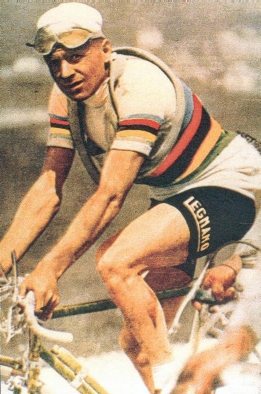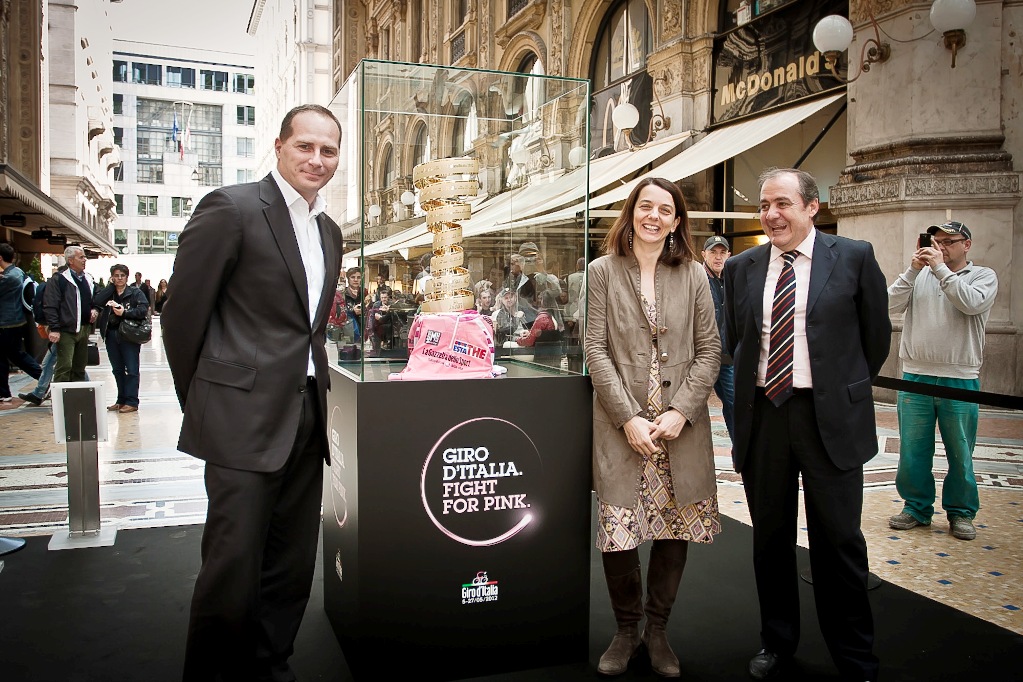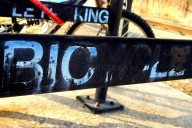Before returning to the 1924 cycling season and looking at one of the more infamous Tours, we zip forward in history one more time to consider what happened to the revenue-sharing debate that sparked the teams’ boycott of the 1924 Giro d’Italia and opened the door for Alfonsina Strada to become the only woman to ride a Grand Tour.
* * * * *
In 1930, a non-appearance fee was paid by the Giro organisers. Alfredo Binda had by then established a stranglehold on the corsa rosa, winning in 1925, 1927, 1928 and 1929, in all of them riding for Legnano. It wasn’t just that Binda kept winning, it was the manner of his victories. In 1927 he had won twelve of the fifteen stages, in 1928 seven of twelve and 1929 nine of fourteen. In all, that’s thirty-three out of forty-one stages in three years. Giro boss Emilio Colombo was getting more than a little bit bored by il campionissimo. More to the point, La Gazzetta dello Sport‘s readers were getting bored by il campionissimo: circulation was down. So a plan was hatched between Colombo and his sidekick Armando Cougnet on one side and Legnano owner Emilio Bozzi and his direttore sportivo, Eberardo Pavesi, on the other: Binda would be politely asked to bugger off.
Bozzi was willing to play ball because Binda taking a dive made commercial sense: another Binda victory wasn’t go to help sell many more bikes. But, at the same time, Bozzi didn’t want to simply surrender and allow Maino or Atala or Bianchi to step in and bag an easy victory. Here Pavesi came to Bozzi’s assistance, promising that he had a talented young rider waiting in the wings who could, quite possibly, profit from the absence of Binda. Pavesi was also concerned that Binda was having life just a little too easy, and had stopped taking cycling as seriously as he should be (or, at least, as seriously as Pavesi thought he should be).
With everyone else on board, it was time to pitch the deal to Binda. He listened to what was being told to him. And he agreed that yes, he was strangling the Giro and that yes, that was unfortunate. It would be best if he stayed away. You can imagine the sigh of relief this must have elicited. Only then Binda delivered an upper cut of sheer elegance. He demanded that, if Colombo really wanted him to stay away, he’d have to pay a non-appearance fee: the equivalent of the first prize, plus six stage wins, plus the bonus Bozzi would have had to pay him if he won. All in, the thick end of 22,500 lire. And even there, Binda claimed, he was being exceedingly generous, as failure to win the Giro would cost him a packet on the post-Giro critérium circuit (even then, riders needed the appearance fees paid on the critérium circuit). Colombo swallowed hard but saw he had little or no choice in the matter. The deal was done. Colombo, having stared down the demands for appearance fees in 1924, caved to the demand for a non-appearance fee. Once again commerce triumphed principles.
At which point appearance fees re-enter this story. Up to now Binda hadn’t taken a tilt at the Tour de France, preferring the Giro. It is said that the reason for this was that Legnano had no business interests in France, but this isn’t entirely true: they were there in force in 1924, and Ottavio Bottecchia’s two victories for Automoto demonstrate clearly that the Italian media gave the French Tour ample coverage, so long as one of their own was winning. The main reason Binda hadn’t bothered with the Tour is more likely to have something to do with that post-Giro critérium circuit; having won the corsa rosa and then filled his boots with the round-the-houses races and track appearances, it’s highly unlikely he was ever in much of a state to tackle the Tour. The fact is, few Giro winners had the legs to tackle the Tour, as we’ll see when we come to look at the 1924 Tour itself, which was graced by the presence of the reigning Giro champion Giuseppe Enrici.
The post-Giro critériums sapping Binda’s strength would not, of course, be the case in 1930. So with Binda now sitting out the Giro, and the Tour having just switched to national team format, Henri Desgrange – it’s claimed – saw an opportunity to get the best Italian rider of the day riding in his race. He offered Binda a generous appearance fee to ride the Tour.
It’s said by some that the reason Binda eventually pulled out of the Tour, ten stages in, eleven stages to go, is that he’d bled Desgrange dry and there was simply no more money to pay him to continue. If you look, though, at the 1930 Tour, you see a possible alternative reason: alongside Binda on the Italian team was Maino’s Learco Guerra, a rising star. When the Italian squadra snatched the maillot jaune on the second stage of the race, it was Guerra who wore it, not Binda, who was twelve seconds off yellow and in third place. The hills were yet to come and he was more than capable of clawing back time once the road went upwards. So Binda had nothing to worry about. Until he lost more than an hour after suffering a major mechanical on the road from Bordeaux to Hendaye, just before the race reached the mountains. That was his race for yellow done for. Time for him to turn to consolation prizes.
The next day, Hendaye into Pau, the campionissimo took the stage win. The same again the day after, Pau to Luchon. And on the third day – Luchon to Perpignan – he retired from the race, with his compatriot Guerra having finally surrendered the maillot jaune and eleven minutes to André Leducq. When the race made it back to Paris, Guerra was just fourteen minutes off Leducq’s pace, and stood standing on the second step of the podium.
It took a lot of spinning to explain Binda’s abandonment of the race, especially with his teammate in yellow and in need of support. Hence, perhaps, the legendary stories of Binda having bled Desgrange dry. The Italian cycling federation tried to claim that their campionissimo was saving himself for the Worlds (which, in fairness, he did go on to win). But many, many years later Binda finally offered his own reason: Colombo had welshed on the Giro deal and the agreed 22,500 lire non-appearance fee had failed to materialise. Even so, Binda was still proud of his ‘victory’ in that 1930 Giro, as he explained to Pierre Chany:
It was my best Giro. I didn’t just get the prizes without riding, but I took up about ten contracts on the track in France, Germany and Belgium. The records say I won the Giro five times, but I consider that I won it five and a half times.”
The appearance fees issue was put to rest – sort of – after the war, with the establishment of the Challenge Desgrange-Colombo, a precursor of the old Super Prestige Pernod trophy and today’s World Tour. To encourage the big teams to send their best riders to all the races making up the season-long competition, the organising journals – L’Équipe in France, La Gazzetta dello Sport in Italy and Les Sports and Sportwereld-Het Nieusblad in Belgium – dangled the carrot of generous travelling expenses under the noses of the teams. Today, Pro Teams in the World Tour races are guaranteed a minimum appearance fee of €7,500 each, with the ASO raising that to €51,443 at the Tour de France. The teams don’t think it’s enough and – as in 1924 – are still agitating for more.
The deal hammered out for the Challenge Desgrange-Colombo races clearly wasn’t the end of the issue. The Tour de France may have been able to attract the cream of the peloton, but the two other Grand Tours – the Vuelta a España and the Giro d’Italia – suffered a little in the shadow of other races, especially the Tour. Too often the Giro was used just as a training ride for the Tour, no more important – for some riders – than the Tour de Romandie which itself served as a leg-loosener for the Giro. So sometimes the Giro organisers had to take out the cheque-book and entice the best riders to put in an appearance.
Appearance fees weren’t the only thing that had the Giro organisers reaching for their cheque-book. Sometimes certain riders – certain Italian riders – needed a little bit of help when it came to ensuring that the maglia rosa stayed in Italy. The stories here are legion, although the facts supporting them are few. But it does seem that the Giro organisers paid for the right result on several occasions. (And sometimes they didn’t even pay, they just helped in other ways, such as cancelling stages and turning a blind eye to infringements of the rules.)
Other times, extra money was spent to liven a race up: consider, for instance, the 100,000 wager La Gazzetta‘s Rino Negri had with Roger de Vlaeminck over how many stages he could win at the 1975 Giro. And, of course, the issue of disappearance fees was also on the agenda that year. When Eddy Merckx‘s Molteni squad was pulled from the 1975 corsa rosa just before the start, the official reason given was that Merckx had taken ill at the Tour of Romandie. Some suspected that Vincenzo Torriani, the Giro’s direttore di corsa, had paid the Belgian off. Italy, at this stage, was so bored with the Cannibal’s reign of terror in the Giro – five victories, plus that near victory in 1969 – that RAI had stopped covering the race live. With Merckx gone and Torriani delivering a corker of a race in 1975, RAI returned to the corsa rosa the following year. Whatever money Torriani had spent on that 1975 Giro, it was a wise investment.
Chucking out money to the odd team or rider here or there was relatively easy to do. Paying off everyone in the race is of a different order of magnitude. Especially given the precarious financial position of the Giro and of its organising journal, La Gazzetta dello Sport. Which, in 1977, was taken over by the RCS group. One of the grand ironies of this take-over was that La Gazzetta was now part of a stable of newspapers that included the Corriere della Sera, that newspaper whose guns La Gazzetta had spiked back in 1908 with their pre-emotive announcement of the Giro d’Italia. And the paper to which La Gazzetta had needed to go cap in hand in order to ensure they had sufficient finances to actually run the inaugural Giro in 1909.
The RCS group had started life in the 1920s when Angelo Rizzoli created a small publishing company, Rizzoli & Co, later to become Rizzoli Editore. In 1974 Rizzoli took over Corriere della Sera and the newly-merged company became Rizzoli-Corriere della Sera. By the end of the seventies, with La Gazzetta now part of the company’s publishing empire, the future should have been bright for RCS.
Things went tits up for RCS in the eighties when they found themselves caught up in the Banco Ambrosiano and the P2 scandals and – in 1982 – went in and out of bankruptcy. The 1982 Giro itself was very nearly cancelled. Vincenzo Torriani, the Giro’s direttore di corsa, had to stand personal guarantor of its debts. Torriani was by now into his sixties and had been running the Giro for three decades. He certainly didn’t need the headache, but he wasn’t going to sit back and watch his race – and it would be fair, at this stage, to call it his race – to be ruined by the financial incompetence of others. Knowing his own shortcomings, Torriani called in a man to do the jobs he himself couldn’t do. That man was Carmine Castellano and, together with Torriani, he set about saving the corsa rosa.
The Giro was saved, in the end, by the arrival of the Seventh Cavalry. Well, the American Coca-Cola corporation, which stepped up to the plate. It wasn’t their black gold that the men from Atlanta showered on the Giro, it was one of their other brands, Sprite (about to be launched in Italy), which became the drink that saved the Giro. (If you think that Coke entered cycling when their bidons began appearing at the Tour de France after 1985, think again. You can even date Coke’s interest in cycling to earlier than 1982: back in 1968 it was their money which had been used in one of the failed attempts to get a young Eddy Merckx to ride the Tour.)
Scroll forward to 2000. In the post-Festina years the Giro suffered heavily from an association with doping, not just through stars like Marco Pantani being laid low by controversy, but also through the Italian judicial authorities making their presence felt at the Giro, raiding hotel rooms and tickling collars with alarming regularity. You would imagine that the teams had enough on their plates at the time but – surprisingly – revenue sharing was again high on their agenda. A group of teams – through the Assogruppi, the Association of Italian Sporting Groups, headed by Moreno Argentin – demanded a share of the Giro’s TV and merchandising revenues. And they figured they knew just what it would take to grab the race organiser’s attention: strike!
Rather than boycotting the race itself – clearly someone had learned a lesson from the 1924 Giro – this time the Italian teams decided they would refuse to participate in their media duties: post-race interviews and podium ceremonies were to be boycotted. Nor would they wear any of the race leader’s jerseys, including the maglia rosa. This they announced on the eighth stage. Moreno Argentin made his position clear:
They are prepared to talk […] but they never talk of the congestion of television rights and advertising. They want to see how strong we are. This is the only sport in the world in which ninety-five percent of the costs are covered by sponsors and five percent by television rights. Riders are paid by us and without riders, there would be no cycling.”
On the tenth stage of the race the Assogruppi took action. Stage winner Ivan Quaranta (Mobilvetta) and maglia rosa wearer Francesco Casagrande (Vini Caldirola) were no-shows on the podium and refused to talk to journalists from La Gazzetta or RAI. Polti’s direttore sportivo Gianluigi Stanga, speaking on behalf of the Italian teams, had this to say:
Bicycle racing changes. Twenty years ago, TV rights were not a topic, but today I think that it’s normal that the teams – and their sponsors who invest in them – get a say in where the money goes.”
The reason the dispute was limited to the Italian teams was that they believed foreign teams were being paid more than they were to ride the Giro. This sort of complaint was typical of the Spanish teams and riders in the Vuelta, especially in the sixties and seventies. Riders regularly complained about the vast sums being lavished on foreign teams in the form of appearance fees, especially when they fielded half-strength squads or just used the Spanish Tour as a warm-up for the Giro. Or even used the Vuelta as a way to make money, selling their services to the highest bidder. Pedro Delgado complained about this aspect of the Vuelta in his autobiography:
Apart from getting paid a good starting fee by the organisation, [the foreign teams] would accept ‘offers’ from the team of an escaped rider in return for not chasing him down. The system of these strong teams, especially the Dutch, was to only allow solitary breakaways, letting them build up a considerable leeway. These teams, filled with powerful road-men, were so dominant they could close down the escape in the final kilometres unless they found some other ‘interest’ in the stage.”
But the fact was the Vuelta needed to pay appearance fees in order to attract the stars of continental European cycling: in the years before and after Franco’s death, Spain was not high on people’s must-visit lists. How much the Giro needed foreign stars – and whether or how much they paid for them – is debatable.
RCS Sport responded to the Assogruppi’s actions with more words. They pointed out the long history of the race. They pointed out how the profits made on the Giro subsidised other RCS Sport events. Then they tried to kick the issue upstairs to the UCI:
The situation demands a careful analysis, in which the organisers and rider representatives must debate responsibly. After that we can perhaps change things. RCS Sport does not believe that such a serious problem can be resolved through a unilateral imposition of a solution, without assessing all of the information and comparing accordingly. The organisers have tried every effort to invite the Assogruppi to the discussions, but emotion seems to have prevailed over logic.
Before answering negatively to the ultimatum given to us by the Assogruppi, we want to verify our own position in the dispute and are seeking UCI president Hein Verbruggen’s opinion. We hope, however, that the Giro can continue as normal, and we would like to start the debate at its conclusion, rather than coming to a hasty compromise.”
The promise of talks, though, was sufficient for the Assogruppi to back down and life in the 2000 Giro returned to normal, or what passed for normality in the Giro in those days. What came of the subsequent talks between Assogruppi and RCS Sport isn’t clear, but nothing really changed, except for the UCI amending its rules with regard to travel expenses and participation allowances.
Appearance fees at the Giro became an issue again when the un-retiring Lance Armstrong made his return to the peloton, with the corsa rosa joining races like the Tour Down Under and the Tour of Ireland in the rush to hand over big bags of swag to the American in order to get him to put in an appearance at their races.
Then we come to last year, and the return to the centre of the stage of the appearance-fees issue, once again linked to TV revenues. At the Tour we had that little strop some of the AIGCP teams pulled, refusing to cooperate with ASO on certain media duties, specifically the issue of in-car race coverage (ironically, one of the points on the AIGCP’s ten-point plan to improve cycling). That doesn’t seem to have endeared them greatly to Marie-Odile Amaury and the attempts to get ASO to hand over a share of their profits – or even engage in talks over handing over a share of their profits – made little progress.
This week’s announcement from Jonathan Vaughters, that the AIGCP and RCS Sport were in advanced negotiations with regard to the issue of revenue sharing at the Giro, suggests that the AIGCP have adopted a different tactic in their negotiations: it’s easier to talk to someone who’s willing to listen and has something to gain from what is being proposed. On the surface, the notion of the Giro sharing a slice of their TV income with the teams makes sense. Michele Acquarone, interviewed by Daniel Friebe, has acknowledged that, over the last few years, the Giro has stood still while the Tour de France has marched forward. This, he knows, has to change:
Now we have to make up ground, and we can do it by trying to convince the biggest stars to come to our race, but it’ll still be their decision. Our biggest weapon in that battle for hearts and minds is the audience; the more people are watching, the more stars will want to come.”
The converse of that is equally true: the more stars who take on the Giro, the more people will watch the race. The Giro, after years of going toe-to-toe with the Vuelta over who can find the toughest climbs, is now living up to its marketing slogan: the hardest race in the most beautiful place. But, in audience share, it is still a league below the Tour. A revenue-sharing deal that’s structured around teams bringing their ‘A’ game to the Giro would help the race as much as it would help the teams. The Tour’s status in the minds of ordinary sports fans as the great bike race could even, finally, be challenged.
But Acquarone has also indicated that he is willing to play a long game with the Giro, and will not necessarily rush to bribe the biggest stars of the day to race the Giro:
What we can do, the only thing, is to build up the biggest possible international audience and grow our race so that our team is ready when a huge star comes along and captures the imagination again. We haven’t had that pied piper effect for the last few years, that excitement, and yet the race has grown, so that at least shows we’re moving in the right direction.”
On the issue of the proposed revenue-sharing deal with RCS Sport, though, it would appear that Vaughters may have jumped the gun to some extent. He himself did indicate that no deal was actually on the table, that the two sides were merely in discussion:
I’m very pleased with the negotiations with RCS and hope to have a deal that’s mutually beneficial at some time in the near future. I’ve been really happy with how RCS and Michele Acquarone has treated the teams. We’re really excited about the possibility of this partnership.”
Now, though, it is being reported that no deal is likely to be reached in the short term. Acquarone has indicated to VeloNews that talks are more likely to take place in the off season, November and December. Acquarone has also indicated that he was surprised to hear an announcement from Vaughters so soon and that any deal would be tied to future TV deals, not current ones. And here one needs to take a step back and look at the RCS Media group as a whole. The group may have turnover north of €2,000 million, but in 2011 they reported losses of more than €300 million, compared to a profit of €7 million in 2010.
A deal with RCS Sport would, of course, open the door to deals with other race organisers and, eventually, ASO. However, what those race organisers have to gain from such a deal needs to be considered. For the smaller events, some form of revenue-sharing deal that guarantees teams will bring their A squads would help generate more revenue from TV rights, a portion of which could be shared with the teams. But what’s in this for ASO?
TV rights for ASO events are currently sold in a package that includes the Tour as well as Paris-Nice, the Critérium International, Paris-Roubaix, the Flèche-Wallonne, Liège-Bastogne-Liège, the Critérium du Dauphiné and Paris-Tours, and other ASO events. A race like Paris-Nice could, perhaps, benefit from the teams taking it more seriously, but is there much to be gained at Paris-Roubaix, Liège-Bastogne-Liège or even the Flèche-Wallonne? Or take the Critérium du Dauphiné – ASO are still trying to bed that race down having only taken it over in recent years, and the level of prize money being paid there suggests it is not yet profitable. But serving as it already does as one of the major pre-Tour warm-up events, can the teams offer ASO more at the Dauphiné?
Consideration also needs to be given to the fact that ASO’s current deal extends through to 2015. If RCS Sport tie a revenue-sharing deal to future TV deals, you can expect the same from ASO. Which suggests no deal with ASO is likely to be forthcoming within the next year or two.
A lot has changed in cycling since Italian teams tried to hold a gun to the heads of the Giro organisers in 1924 in an effort to gain a greater slice of the cake. Down through the years progress has been made on the issue of appearance fees and the teams have managed to extract a larger slice of the cake from race organisers. Whether we’re really on the cusp of a new deal, or whether we are seeing a repeat of 2000 – talks that ultimately go nowhere – well, only time will tell.
















1 Comment
[…] to Alfonsina Strada (part 4) and the role played by the Giro in the revenue-sharing debate (part 5). We now turn to the other Grand Tour, some more heroes of our sport, and one of cycling’s […]